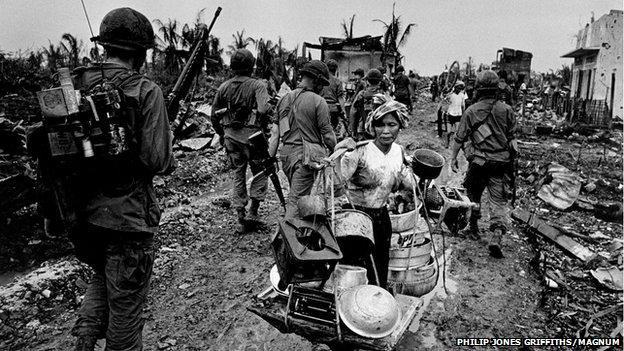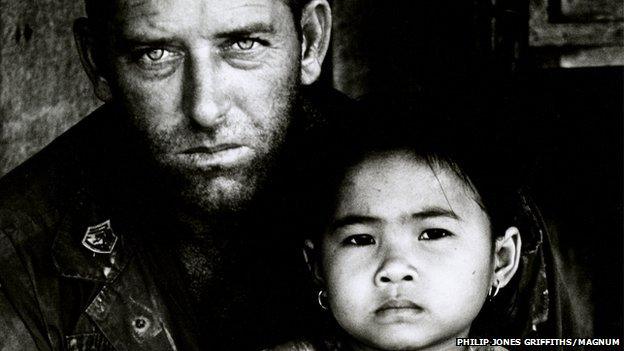Permanent home for Vietnam war photographer's work
- Published

District 8 Saigon, 1968
The daughters of renowned Welsh photographer Philip Jones Griffiths say they are "extremely satisfied" that his archive will be permanently housed at the National Library of Wales.
Griffiths' iconic images of the Vietman War have gone on display in Aberystwyth, after years of wrangling over a long-term home for his work.
The library will house 150,000 slides and 30,000 prints which he produced.
But some have said his work should be on display in Cardiff.
His daughters Katherine Holden and Fanny Ferrato attended the official opening of an exhibition of some their father's work at the Library's Oriel Gregynog, where it will remain on display until December.
Griffiths was born in Rhuddlan, Denbighshire, in 1936 and initially worked as a photographer for the Guardian and the Observer, before travelling to Vietnam in 1966 for the Magnum photo agency.
He is credited with helping to end the war through the publication of his powerful images of the conflict, which were published in a book called Vietnam Inc. in 1971.

US soldier giving covering fire to the men in his unit pinned down by Vietcong fire on the outskirts of Saigon, 1968
He later went on to photograph other conflicts zones, including Northern Ireland. He died from cancer in March 2008.
'Proud Welshman'
Mrs Holden said: "We're overwhelmed. We are so pleased with this exhibition. Not only have they shown his work beautifully, but they've also captured a little piece of him.
"For us, it was very emotional coming here to see the work. We were in tears."
"He was an extremely proud Welshman, and wanted his work to remain in Wales. The partner that we've found in the National Library is everything that we could have asked for.
"This exhibition is the result of shipping hundreds of boxes over from his apartment in New York, and [the library staff] are really the ones who have gone through it all, and found this wonderful material. We could not be more pleased."
Fanny Ferrato added that there were hopes for a wider audience for their father's work.
"Maybe we could do a travelling exhibition through Wales? And we will definitely have more schools come to see the exhibition while it's at the National Library of Wales. It's a great start and we're really, really proud," she said.
Katherine Holden said the National Library was the perfect location for the archive. "I can't think of anywhere safer. It was Philip's dream to maybe develop a centre that students could come and stay at, and it's something we may pursue. But in terms of the work having found its home, we are extremely satisfied."

Detail from Marine and child
The exhibition was opened by Lord Dafydd Wigley, the former president of the National Library, who had personally negotiated the transfer of the Philip Jones Griffiths archive to Aberystwyth.
"I think his dream was to have a farm halfway up Snowdon, which could be a centre for learning about photography and where all his work could be kept.
"That wasn't practical, but the next best thing was that it was in good hands here in Wales. There was initially a bit of doubt as to whether it would be appropriate to keep it in a library or a museum, with the idea that things might be buried and away from sight.
"But once the daughters, the trustees of his foundation, saw the capacity, the skills and talents in the National Library, they saw this was the place to be."
'Ranks with the best'
One of Philip Jones Griffiths's closest friends, fellow Magnum photographer David Hurn, remains sceptical about housing the archive in Aberystwyth, and would prefer to see the most significant images on display in Cardiff.
"It's terribly easy now for work to be lost and forgotten. In my opinion the kiss of death is that your archives go to a place where nobody sees it.
"It is important, in Philip's case, that - somewhere - there should be an archive of at least 500 of his best pictures.
"It is only two hours from London to Cardiff, and if we only had the stuff in Cardiff people who were interested in photography would come there on the train. They would see the work of a great Welsh person, and that's what Wales should be pushing for.
Mr Hurn added that Philip Jones Griffiths still enjoyed global recognition in his field.
"If you go and talk to any photographer in America or Australia, they would have heard of Philip Jones Griffiths. There are very few Welsh artists that you could say that about, and I think it's true to say that he ranks with the best photographers that there have ever been."
Philip Jones Griffiths - A Welsh Focus on War and Peace is at the National Library of Wales, Aberystwyth, until 12 December 2015.